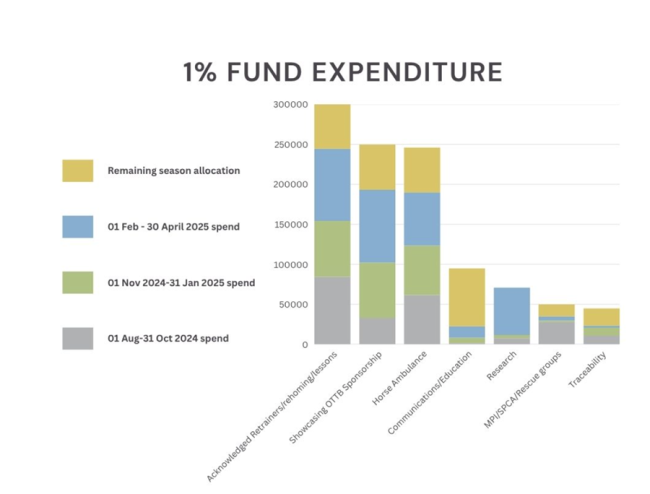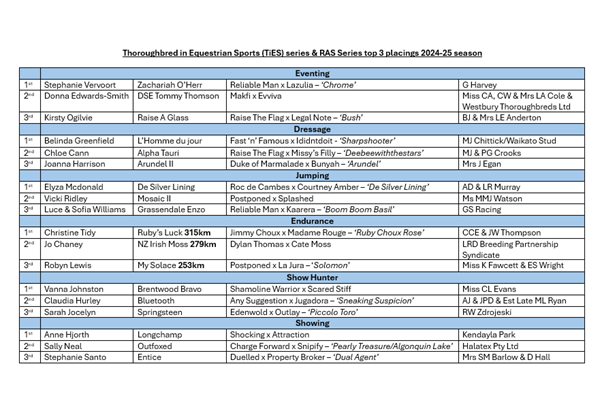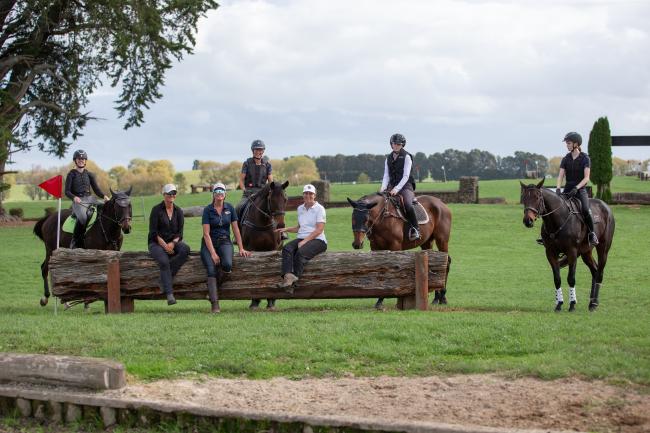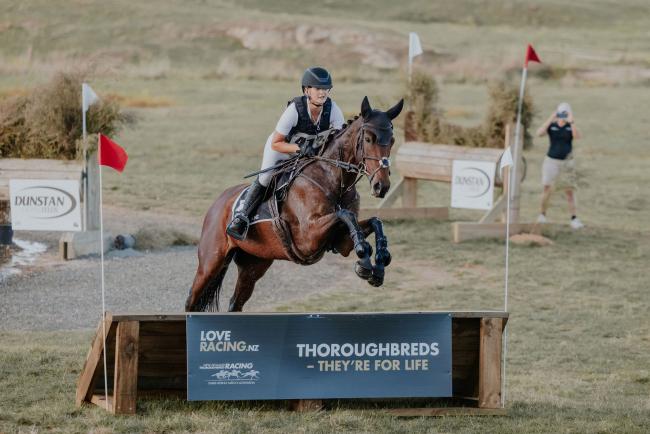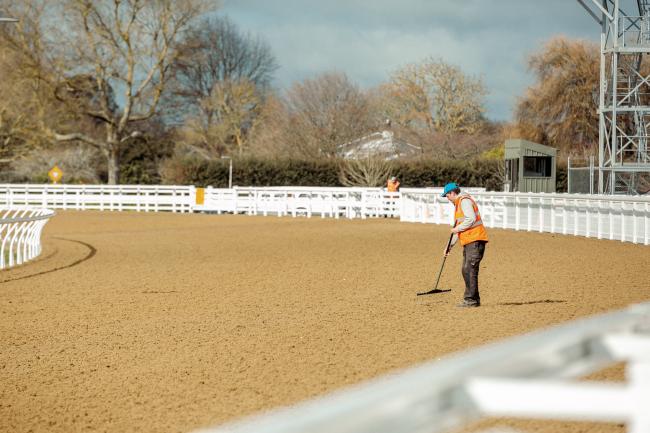This edition of the 1% newsletter covers the third quarter, from February to May 2025.
At the completion of the third quarter the spend is within budget, with a total of $329,115 allocated during this time. The total spend this term is $775,906 so far, with our budgeted total for the 2024/25 season at $1,052,192.
This quarter's focus was celebrating thoroughbreds in their lives after racing. The Welfare and Sustainability team has attended many of the equestrian events which the 1% levy supports and it has been wonderful seeing our versatile thoroughbreds in action. Highlights include being present at the Horse of the Year Show in Hawkes Bay for the TiES Series finals, NZ Polo Open, and our inaugural $5k Eventing Stakes hosted by the Matamata Equestrian Group in the heart of thoroughbred country.
It was great to see the pathway this provides in action with Monica Spencer and the Windsor Park-bred ‘Max’ lodging several top 10 placings on the international stage.
Our strategic spend has also provided education and support via our Know Your Thoroughbred Clinics for those who have selected a thoroughbred as their sport horse of choice. These events focus not only on riding but also horsemanship, which is an important aspect of our sport. Our Thoroughbred Ambassadors, Donna and Elise Edwards-Smith play a pivotal role in the success of these clinics, and for this we are incredibly grateful.
We continue to direct funding to support horses via the NZTR Acknowledged Retrainers Network. Located around New Zealand, these dedicated individuals support the transition from racehorse to sport horse. The challenges of providing homes for horses from their racing careers continue across the industry, and solutions are not always easy to navigate.
Other fund allocations included the NZ Horse Ambulance Trust, research, traceability, communications, education and welfare assistance.
This includes the Synthetic Track document, commissioned to provide a detailed summary of the physical characteristics of New Zealand’s synthetic tracks, current maintenance practices, and performance metrics. One of the key recommendations from the Massey University report is the establishment of a coordinated NZTR Quality Assurance Programme. This initiative aims to ensure a consistent and uniform racing surface across the three synthetic venues: Cambridge, Awapuni, and Riccarton.
An update on the Equine Crematorium that it is now fully operational for the new season. Located in Rangiriri, the facility will operate under The Rural Guardian Trust, which has been granted charitable status. The establishment of the crematorium has been made possible in part through funding support from the 1% Welfare Levy, highlighting the industry's ongoing commitment to equine welfare. A significant portion of profits will be reinvested into equine initiatives and research. While horses will not be euthanised at the crematorium, it offers a dignified and environmentally responsible method of disposal that meets both ethical and industry standards.
Please don’t hesitate to reach out with any feedback, questions or comments.
Justine Sclater
NZTR Head of Welfare and Sustainability
Acknowledged Retrainers Funding
Third Quarter Spend: $90,310 (YTD:$244,586 - Season Allocation: $300,000)
To the end of April, 213 horses have arrived at an NZTR Retrainer and 207 have been rehomed this season.
March and April saw an increase in horses being rehomed, which coincided with the end of the drought season and the main equestrian sport season.
Spend breakdown:
- Retrainer Fees (Arrival and Traceability Fee): $44,300
- Leg Up Grant (Arrival checks, farrier, teeth and injury): $43,853
- Safety Gear Grants and Miscellaneous: $2157
OTTB Versatility Sponsorship
Third Quarter Spend $90,997 (YTD 193,387 – Season Allocation $250,000)
Off The Track Thoroughbred support and sponsorship can be broken down into four main areas.
TiES (Thoroughbreds in Equestrian Sports)
Third Quarter Spend: $66,054 (YTD: $82,947)
The Defender Horse of The Year was held during the third quarter. This showcases the culmination of riders’ hard work and training and awards were given for TiES series winners in the Futurity competition, Show Jumping Accumulator, Show Hunter Accumulator and Dressage/Para Dressage Accumulator. Note the Endurance and Eventing Accumulator awards are presented in the fourth quarter as their season runs later.
Know Your Thoroughbred Clinics
Third Quarter Spend: $7,511 (YTD: $21,630)
The Know Your Thoroughbred clinics offer riding and horsemanship lessons in a safe and supportive environment, facilitated by professionals who have experience working with off the track thoroughbreds. A clinic facilitated by Donna and Elise Edwards Smith was held in Ōhaupō with over 30 combinations attending. The facility is stunning and has both an indoor arena and extensive cross-country area.
Two further clinics were scheduled and held in July (Christchurch and Taupo).
Clinic Participants with Donna Edwards Smith, Elise Edwards Smith and Tracey Oakes NZTR at the Ōhaupō Equestrian Centre.
Polo
Third Quarter Spend : $4,949 (YTD: 32,615)
There were a total of 592 thoroughbreds registered to play polo this season.
This quarter saw the conclusion of the polo season and it was pleasing to see thoroughbreds standout at highlight events such as the Auckland Open.
The 135th Saville Cup was held in the South Island, hosted by the South Island Polo Association at Glenmark Polo, Omihi (just north of Christchurch). A total of 192 thoroughbreds took to the field during the 6-day Tournament.
Other Sponsorship
Third Quarter Spend: $12,482 (YTD $56,194)
This area includes independent events such as local sports days (Whangaehu Horse Sports, Makirikiri Horse Sports and Distance Riding New Zealand).
We also have some costs in this quarter for the inaugural 5k Eventer Stakes held at the Matamata Equestrian Groups National One Day Event in March. The remainder of the costs will be allocated in the fourth quarter.
Anna Rehab received their quarterly payment. They have been out and about in the community promoting the use of thoroughbreds in Equine Assisted Learning. They were recently interviewed by Radio New Zealand about the work they do. A link to that interview can be found here.
Merchandise was purchased for prize packs and the new jump for the main arena at Defender Horse of the Year was branded to promote the 1% Welfare Levy and OTTB thoroughbreds. This was on show in the main arena over the 5 days of competition.
Brittany Fowler on Margarita Time (Reet Petite by Rip Van Winkle x Silk Chardonnay) competing at the inaugural 5K Eventer Stakes in Matamata. Photo: Nicole Troost
Welfare Assistance
Third Quarter Spend: $5,227 (YTD $34,922) – Season Allocation $50,000)
March saw NZTR step in and assist the SPCA with the uplift of two thoroughbreds in poor condition. The Horse Ambulance was utilised and the horses safely delivered to an SPCA foster home provider to gain strength before being relocated to an NZTR regional care farm. The horses have continued to gain condition and strength under veterinary observation and are now much improved.
NZTR also assisted the RIB with two horses that had been abandoned on a rental property. The owner eventually surrendered the horses to the RIB and they were then relocated to an NZTR Regional Care Farm.
Research
Third Quarter Spend: $59,368 (YTD $67,173 – Season Allocation $65,000)
The majority of the research spend was allocated to post-mortems and the Equine Mortality Review Panel (EMRP) to ensure any mortality associated with a race day in New Zealand (up to 72 hours after a race day), which has been extended to include trial fatalities where possible.
This ensures the ability to share and compare data with overseas colleagues and jurisdictions, and postmortems follow the protocols utilised by the Horse Racing Industry Safety Authority (HISA). It is important work to determine whether identifiable factors may have contributed to a horse’s death.
The remainder of the spend was allocated for the use of the equimetre system and data collection to examine variability in stride and ground surface. This pilot project aims to test the feasibility of using the equimetre system to quantify the pattern (temporal pattern of the canter and gallop) and examine if we can measure variation in gait associated with the training surface.
Traceability
Third Quarter Spend: $2,471 (YTD: $23,324 - Season Allocation: $45,000)
NZTR’s commitment to lifetime traceability in partnership with the New Zealand Companion Animal Register (NZCAR) is growing momentum. There have been 282 retired thoroughbreds submitted to the NZCAR.
Horse Ambulance
Third Quarter Spend: $66,565 (YTD: $190,025 - Season Allocation: $246,192)
As well as the regular allocation of funds to the NZ Horse Ambulance Trust, this season we launched a new initiative to support the presence of a horse ambulance at premier equine events. These 10 events included the Defender Horse of the Year.
This initiative demonstrates our commitment to emergency response for our entire equine community, not just racing.
Communication and Education
Third Quarter Spend: $14,177 (YTD: $22,489 - Season Allocation: $95,000)
The main spend in this area was on the completion of the synthetic track review
Prior to the commencement of the 2024 synthetic track racing season, New Zealand Thoroughbred Racing (NZTR) commissioned Professor Chris Rogers, in partnership with Massey University, to produce a comprehensive track discussion document. The objective was to consolidate the latest international research on racing surfaces, with a particular focus on the physical properties of synthetic tracks and how surface management influences hoof-surface interaction.
The document provides a detailed summary of the physical characteristics of New Zealand’s synthetic tracks, current maintenance practices, and performance metrics. It also draws on global literature to contextualise New Zealand’s synthetic racing environment and describes the physical properties of synthetic racing surfaces, as well as how management can alter the hoof- surface interaction.
Key Findings from the International Literature and Domestic Racing Venue Engagement:
- Different track surfaces exhibit distinct hoof-loading profiles. Synthetic tracks demonstrate a sharper deceleration of the hoof on impact compared to turf tracks.
- Horses adapt limb tension at impact based on their previous experience with a given surface.
- Injury rates on New Zealand synthetic tracks are in line with international benchmarks, though slightly higher than those observed on domestic turf surfaces.
- Horses are recording faster speeds on synthetic tracks compared to turf tracks during the synthetic season.
- Like turf tracks, synthetic surfaces are responsive to environmental conditions such as temperature, as well as to maintenance and preparation protocols.
One of the key recommendations from the Massey University report was the establishment of a coordinated NZTR Quality Assurance Programme. This initiative aims to ensure a consistent and uniform racing surface across the three synthetic venues: Cambridge, Awapuni, and Riccarton Racecourses.
The spend was also allocated to purchasing photos from Horse of the Year, the transportation of Werther and Ping Hai Star to Living Legends, and a gift for Elizabeth Charleston who does a wonderful job promoting thoroughbreds in their lives after racing on her social media channels.
Your feedback is always welcome.
Please email Justine Sclater at Justine.sclater@nztr.co.nz.





